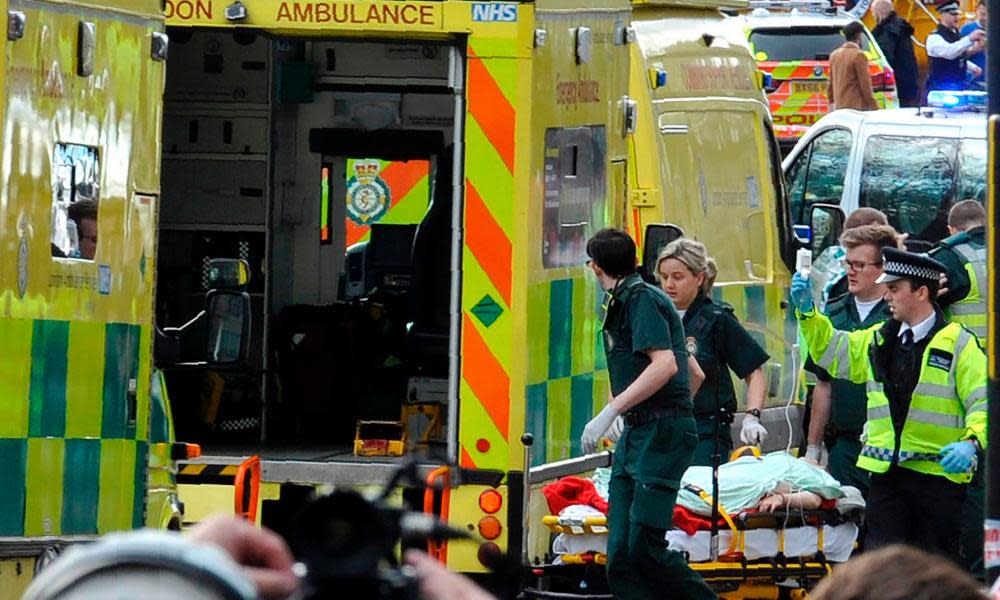Westminster attack medics: 'It was a day London has trained for'

It was a typically busy day in the emergency department at King’s College hospital when Dr Emer Sutherland started receiving text messages from relatives and friends.
They were the first indication of the scale of the horror unfolding just two miles down the road in Westminster. Within minutes, she and her colleagues were on major alert and preparing to receive the first of many critically injured casualties.
“We are a major trauma centre so we are used to dealing every day with majorly injured patients, such as people who have been hit by a car or stabbed,” said Sutherland, who is the consultant clinical lead for the hospital’s A&E department.
But even for her, a highly experienced A&E doctor, it had an impact. “It’s always emotional when you are working on a day like that. Trauma cases are always emotional because you have to quickly treat someone who’s critically injured and who might die.”
Just after 3pm, King’s received the first of eight casualties from the attack, two of whom were critically ill.
“At one point we were treating six of the eight casualties in the emergency department at the same time,” Sutherland said.
“It was very busy, but doctors and nurses were focused and calm.
“Extra colleagues came to help from operating theatres across the hospital, extra pharmacists came with additional supplies, extra radiologists came to do and interpret scans and extra porters came to move patients. That helped reassure the A&E staff. Everyone played their part.”
Wednesday will be remembered, among other reasons, for theresponse of NHS staff across the capital.
Junior doctor Colleen Anderson, 25, was among staff from St Thomas’ hospital who treated injured victims in the immediate aftermath of the attack.
She said she saw victims strewn across the bridge. “There were some with minor injuries, some catastrophic. Some had injuries they could walk away from, others had life-changing injuries. I was there doing anything that I could, just like everyone else,” she said.
Anderson wrote in a Facebook post 24 hours after the attack: “Days like these bring people together. No act is too small. I’ve said it before and I will say it again, I couldn’t be more proud to be a part of the NHS.”
For Dr Fenella Wrigley, the medical director of the London ambulance service, Westminster Bridge was the second major terrorist attack she has been involved in. In all, 68 paramedics and ambulance crew members from the service were deployed to help.
“Wednesday was an incident that the UK and London in particular has trained and planned for, something you hope would never happen,” she said.
“I’m immensely proud of my colleagues and all the emergency services. But it was also a very sad day because people lost their lives and a member of the emergency services lost their lives.
“And I’m pleased that we were also able to help people who were scared but not injured – bystanders who were very scared because of what they had witnessed or because someone they knew had been involved.”
For her, like Sutherland at King’s, it was an emotional day. “It brought back many memories for those of us who were deployed on 7/7 in 2005.
“I was one of those who attended on 7/7. I was working at the time as a doctor with London’s air ambulance service.
“I’m now in a command position. But on Wednesday I could relate to what the paramedics, frontline crews and police officers were witnessing, having done that myself on 7/7.”
Dr Jeeves Wijesuriya, chair of the junior doctors’ committee at the British Medical Association, had been giving an interview to the BBC when the attack began. He was among those who ran to help the stabbed police officer Keith Palmer and the attacker.
“I saw the screaming and ran to help,” he told the BBC. “The police got me in to help at the scene. We gave the officer cardiac massage and spent 52 minutes trying to resuscitate the other man.
“We did everything we could, in terms of basic life support and starting to triage injured people at the scene.”
Dr Tony Joy was onboard London’s air ambulance, which landed in Parliament Square within six minutes of being alerted to the attack. The team treated 10 people injured on Westminster Bridge.
“We were immediately on scene and started to asses the casualties, and looked for information about how many other patients there might be,” he told the BBC.
Within 24 hours of the attack, the air ambulance – a charity – had received £10,000 in donations from members of the public. In a statement, it said it was “blown away” by the level of generosity shown.

 Yahoo News
Yahoo News 
